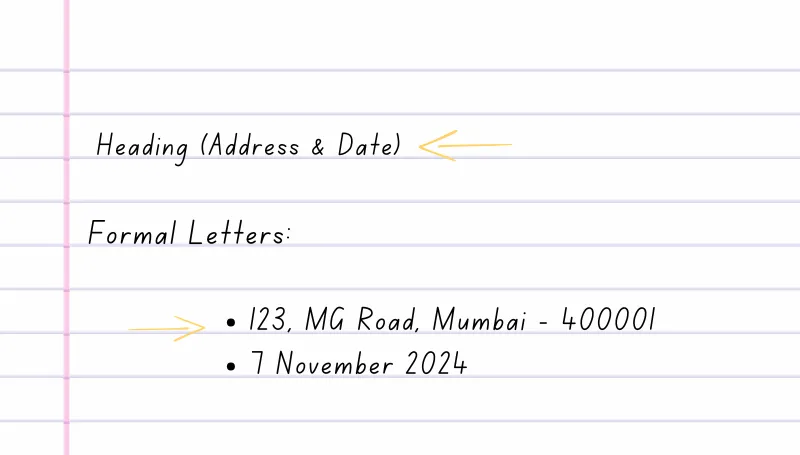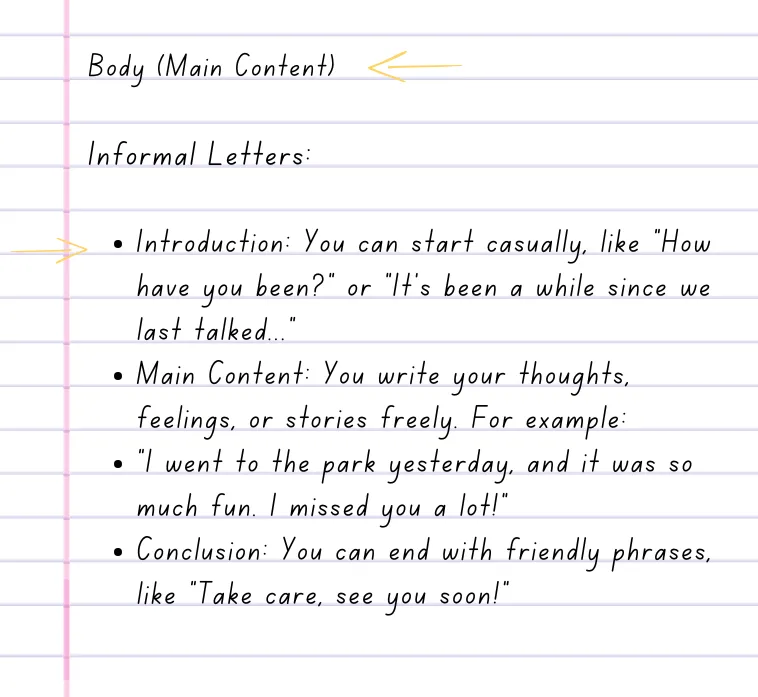Learn the Basic Art of Letter Writing: Simple Steps to Perfect Every Letter
Published: 7 Nov 2024
Welcome to Dear Learners!
Ravi decided to write a letter to his grandmother to share stories from his school trip. He felt excited, but as he sat down to write, he struggled to figure out where to start and how to organize his letter.
It’s like trying to cook a recipe but not knowing the right order of ingredients. If the ingredients aren’t used correctly, the dish won’t turn out well. Similarly, a letter needs the right Basic letter format to arrange your thoughts effectively.
“A good letter is one that carries the writer’s emotions to the reader.” That’s why understanding the format is so important.
Today, we will teach you a simple and easy format that will not only make your writing clearer but also help convey your ideas more effectively.

In this article, we will explore what a basic formatting of a letter is, why it’s important, and the main body parts of a letter. We will also discuss the advantages and disadvantages to help you write a correct basic format letter. Just a little focus and regular practice, and you too will become a pro at writing the perfect letter.
You will never have to hesitate before writing a letter again; you’ll be able to express your thoughts clearly and effectively. So, let’s dive in and learn together!
1. What is a Basic Letter Formating?
A basic letter format is a way of organizing your writing in a clear and understandable manner. Just like a good story needs a beginning, middle, and end, every letter follows a basic structure. This format includes some essential parts, like the salutation (greeting), introduction, main body, and closing.
When you follow this structure, writing a letter becomes as easy as following a simple recipe. It acts like a guide, helping you arrange your thoughts systematically so that the reader understands everything clearly.
2. Why is it Important? Understanding the Significance of Letter Formats

When Ravi was writing a letter to his grandmother, he realized how important it is to follow a letter-writing format. Just as the right recipe makes food better, a good letter should also be written in a proper format. Here are some reasons why following a letter format is essential:
Quick Overview:
- Clear Communication
- Professionalism
- Building Connection
- Avoiding Confusion
- Enhancing Writing Skills
- Easier for Readers
- Cultural Sensitivity
1. Clear Communication
When you follow the correct format, your thoughts are easily understood. The format makes your message clear and organized. Just like a good book has chapters, letters should have sections to make it easier for the reader to understand.
2. Professionalism
If you need to write a letter in an official or professional context, following a format is crucial. It presents you as a serious and responsible writer. Your professionalism will be evident in every aspect of the letter, helping to improve your image.
3. Building Connection
A good format can help your letters reach the heart of the reader. When your letter is structured and logical, the reader can better feel your emotions and thoughts. Just as Ravi effectively expressed his feelings while writing to his grandmother, you can also present your emotions clearly.
4. Avoiding Confusion
When letters are written without any format, it becomes challenging for the reader to understand. If your letter is a jumble of random ideas, it will be difficult to convey your message effectively. Using a format keeps your message clear and focused.
5. Enhancing Writing Skills
A good letter format is not just a necessity; it’s also a way to improve your writing skills. When you regularly follow a format, your writing fluency and confidence increase. It makes you a better communicator, which can be beneficial in any context.
6. Easier for Readers
When you follow a consistent format, it becomes easier for readers to read your letter. Letters that are easily digestible tend to receive better responses. People prefer letters that are structured and easy to understand.
7. Cultural Sensitivity
Every culture has its own letter-writing style. If you are targeting a specific audience, it’s essential to understand and adhere to their cultural norms. This makes your letter even more impactful.
A good letter format is not just a requirement; it serves as a way to enhance your writing skills. Now that you understand why following a format is important, let’s move on to the basic parts of a letter and their significance!
3. Basic Parts of a Letter

When planning to write a letter, it’s essential to understand that the basic body parts of formal and informal letters are mostly the same, but their style and tone differ significantly. First, let’s take a quick
Quick Overview:
- Heading: Both types of letters include the address and date.
- Salutation: The way you greet the reader differs in formal and informal letters.
- Body: This is where the differences are most evident, as the main content is structured and written differently.
- Closing: The style of concluding the letter varies between formal and informal letters.
- Signature: The style of the signature is also different for each type.
Now, let’s dive into the details of each part to help you understand the differences clearly:
1. Heading (Address & Date)
- Formal Letters: The heading includes the sender’s complete address and the date in a proper format. For example:
- 123, MG Road, Mumbai – 400001
- 7 November 2024

- This is essential in formal letters so that the reader knows where the letter is coming from and when it was written.
- Informal Letters: You can also include the address and date here, but it’s okay to skip them if it’s a casual letter, like writing to a friend. For example:
- 07/11/2024

2. Salutation (Greeting)
- Formal Letters: The salutation is more respectful and professional, such as:
- “Dear Mr. Sharma,”
- “Respected Sir/Madam,”

- Formal letters use titles, which set a respectful tone.
- Informal Letters: Here, you can keep the tone friendly and casual, like:
- “Hi Neha,”
- “Hey Didi,”

- Using first names directly adds warmth and a personal touch to the letter.
3. Body (Main Content)
The body is the most essential part of the letter. The tone and structure differ significantly between formal and informal letters.
- Formal Letters:
- Introduction: Start the letter formally, like “I am writing to inform you…” or “I would like to request…”
- Main Content: It is structured, clear, and to the point, so the reader understands easily. For example:
“I would like to draw your attention to the issue of water leakage in the building. Immediate repairs are needed.” - Conclusion: End the letter politely, like “Thank you for your consideration.”

- Informal Letters:
- Introduction: You can start casually, like “How have you been?” or “It’s been a while since we last talked…”
- Main Content: You write your thoughts, feelings, or stories freely. For example:
“I went to the park yesterday, and it was so much fun. I missed you a lot!” - Conclusion: You can end with friendly phrases, like “Take care, see you soon!”

4. Closing (Ending Words)
- Formal Letters: Use professional and respectful closing phrases:
- “Yours sincerely,”
- “Yours faithfully,”
- These give a proper, formal ending to the letter.
- Informal Letters: You can use casual and friendly words:
- “Lots of love,”
- “See you soon,”
- These phrases create a warm and personal feel to the letter’s closing.

5. Signature (Name)
- Formal Letters: It’s essential to include your full name, sometimes even your designation:
- “Ravi Kumar, Manager”
- This tells the reader who wrote the letter and from what position.
- Informal Letters: Just your first name is enough:
- “Ravi”
- Your friend will easily understand who wrote the letter, so there’s no need for much formality.

These are the basic parts of formal and informal letters. Understanding them makes letter writing easier, and you can confidently write both types of letters!
4. Advantages and Disadvantages of Using a Proper Letter Format
Understanding the importance of a proper letter format is essential for effective communication. Below are some advantages and disadvantages that highlight how the format can impact your writing:
| Advantages of Proper Letter format |
|---|
|
| Disadvantages of Proper Letter format |
|---|
|
Frequently Asked Questions on Basic Letter Format
This section answers common questions about letter writing and its basic structure, helping you master both formal and informal letter formats.
The basic format of a letter typically includes a heading, greeting, body, closing, and signature. It can vary depending on the type of letter.
A formal letter follows a clear structure with a formal greeting, body paragraphs stating the purpose, and a polite closing.
There are mainly two types: formal and informal letters. Formal letters are used for professional or official communication, while informal letters are for personal use.
The body should clearly express the purpose of your letter, organized into paragraphs that explain the main message in a concise and structured way.
Yes, especially in formal letters, a subject line helps the reader understand the main point of your letter quickly.
The salutation or greeting is used to address the recipient. It sets the tone for the letter and varies based on the formality of the letter.
A formal letter typically ends with a respectful closing, such as “Sincerely” or “Yours faithfully,” followed by your signature.
The tone of your letter should match the purpose and the recipient. A formal letter should have a respectful and professional tone, while an informal letter can be more relaxed.
Yes, bullet points can be used in formal letters for clarity, especially when listing important points or instructions.
Practice writing letters regularly, study different formats, and always proofread your letters to avoid mistakes and improve your writing style.
Conclusion:
Let’s have a quick overview to wrap up everything we’ve discussed:
- Understanding the basic format of a letter is like having a roadmap; it guides you step by step to your destination without getting lost. Whether you’re writing to a friend or in a professional setting, following the proper format ensures that your thoughts are clear and well-organized.
- Each part of a letter, from the greeting to the closing, plays a crucial role in effective communication. Knowing the differences between formal and informal letters helps you set the right tone and approach.
- While learning the correct format might feel like assembling a puzzle at first, with practice, it brings professionalism and clarity to your writing. Just as Ravi learned to express his emotions effectively by following a structured format, you too can enhance your writing skills by mastering these simple guidelines.
So, what do you think? Share your thoughts in the comments below, and don’t forget to follow us on social media for more tips on writing the perfect letter!

- Be Respectful
- Stay Relevant
- Stay Positive
- True Feedback
- Encourage Discussion
- Avoid Spamming
- No Fake News
- Don't Copy-Paste
- No Personal Attacks

- Be Respectful
- Stay Relevant
- Stay Positive
- True Feedback
- Encourage Discussion
- Avoid Spamming
- No Fake News
- Don't Copy-Paste
- No Personal Attacks







